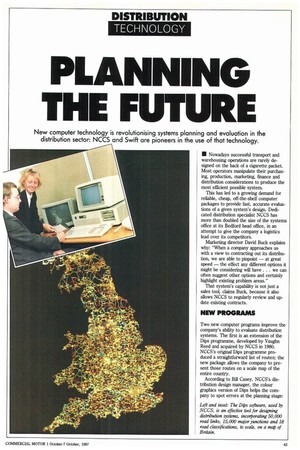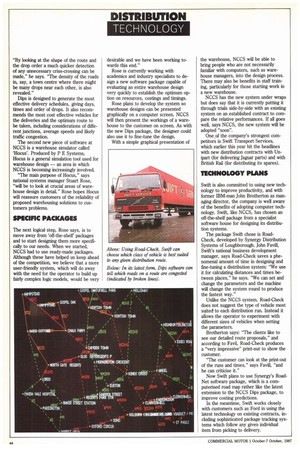PLANNING THE FUTUR
Page 45

Page 46

If you've noticed an error in this article please click here to report it so we can fix it.
New computer technology is revolutionising systems planning and evaluation in the distribution sector: NCCS and Swift are pioneers in the use of that technology.
11 Nowadays successful transport and warehousing operations are rarely designed on the back of a cigarette packet. Most operators manipulate their purchasing, production, marketing, finance and distribution considerations to produce the most efficient possible system.
This has led to a growing demand for reliable, cheap, off-the-shelf computer packages to provide fast, accurate evaluations of a given system's design. Dedicated distribution specialist NCCS has more than doubled the size of the systems office at its Bedford head office, in an attempt to give the company a logistics lead over its competitors.
Marketing director David Buck explains why: "When a company approaches us with a view to contracting out its distribution, we are able to pinpoint — at great speed — the effect any different options it might be considering will have. . . we can often suggest other options and certainly highlight existing problem areas."
That system's capability is not just a sales tool, claims Buck, because it also allows NCCS to regularly review and update existing contracts.
NEW PROGRAMS
Two new computer programs improve the company's ability to evaluate distribution systems. The first is an extension of the Dips programme, developed by Vaughn Reed and acquired by NCCS in 1980. NCCS's original Dips programme produced a straightforward list of routes; the new package allows the company to present those routes on a scale map of the entire country.
According to Bill Casey, NCCS's distribution design manager, the colour graphics version of Dips helps the company to spot errors at the planning stage: "By looking at the shape of the route and the drop order a much quicker detection of any unnecessary criss-crossing can be made," he says. "The density of the roads in, say, a town centre where there might be many drops near each other, is also revealed."
Dips is designed to generate the most effective delivery schedules, giving days, times and order of drops. It also recommends the most cost effective vehicles for the deliveries and the optimum route to be taken, including considerations of different junctions, average speeds arid likely traffic congestion.
The second new piece of software at NCCS is a warehouse simulator called 'Hocus'. Produced by P E Systems, Hocus is a general simulation tool used for warehouse design — an area in which NCCS is becoming increasingly involved.
"The main purpose of Hocus," says national systems manager Stuart Rose, "will be to look at crucial areas of warehouse design in detail." Rose hopes Hocus will reassure customers of the reliability of proposed warehousing solutions to customers problems.
SPECIFIC PACKAGES
The next logical step, Rose says, is to move away from 'off-the-shelf packages and to start designing them more specifically to our needs. When we started, NCCS had to use ready-made packages. Although these have helped us keep ahead of the competition, we believe that a more user-friendly system, which will do away with the need for the operator to build up fairly complex logic models, would be very desirable and we have been working towards this end."
Rose is currently working with academics and industry specialists to design a new software package capable of evaluating an entire warehouse design very quickly to establish the optimum option on resources, costings and timings.
Rose plans to develop the system so warehouse designs can be presented graphically on a computer screen. NCCS will then present the workings of a warehouse to the customer on screen. As with the new Dips package, the designer could also use it to fine-tune the design.
With a simple graphical presentation of the warehouse, NCCS will be able to bring people who are not necessarily familiar with computers, such as warehouse managers, into the design process. There may also be benefits in staff training, particularly for those starting work in a new warehouse.
NCCS has the new system under wraps but does say that it is currently putting it through trials side-by-side with an existing system on an established contract to compare the relative performances. If all goes well, says NCCS, the new system will be adopted "soon".
One of the company's strongest competitors is Swift Transport Services, which earlier this year hit the headlines with new distribution contracts with Unipart (for delivering Jaguar parts) and with British Rail (for distributing its spares).
lICHNOLOGY PLANS
Swift is also committed to using new technology to improve productivity, and with former IBM-man John Brotherton as managing director, the company is well aware of the benefits of adopting computer technology. Swift, like NCCS, has chosen an off-the-shelf package from a specialist software house for designing its distribution systems.
The package Swift chose is RoadCheck, developed by Synergy Distribution Systems of Loughborough. John Favill, Swift's national business development manager, says Road-Check saves a phenomenal amount of time in designing and fine-tuning a distribution system: "We use it for calculating distances and times between places," he says. "We can set and change the parameters and the machine will change the system round to produce the fastest way."
Unlike the NCCS system, Road-Check does not suggest the type of vehicle most suited to each distribution run. Instead it allows .the operator to experiment with different sizes of vehicles when setting the parameters.
Brotherton says: "The clients like to see our detailed route proposals," and according to Favil, Road-Check produces a "very impressive" print-out to show the customer.
"The customer can look at the print-out of the runs and times," says Favill, "and he can criticise it."
Now Swift plans to use Synergy's RoadNet software package, which is a computerised road map rather like the latest extension to the NCCS Dips package, to improve costing predictions.
In the meantime, Swift works closely with customers such as Ford in using the latest technology on existing contracts, including sophisticated package tracking systems which follow any given individual item from picking to delivery.












































































































